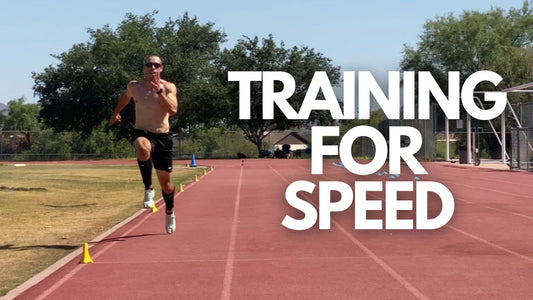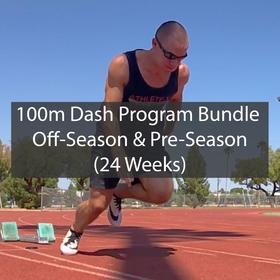Speed Training - A Complete Guide On How To Run Faster
In sports and running, speed is everything. Become a better athlete and learn how to run faster with this complete guide on speed training.
Speed Training
Speed training is a term that is used to describe a wide range of different forms of training. Unfortunately, many of the training labeled as speed training actually does nothing to make you run faster.
From "speed ladders" to fancy exercises that go viral on Instagram, the fact is there are many people trying to sell you a false bill of goods as it relates to speed training.

The simple truth to speed training is that, if you want to run faster, you need to perform speed training sprinting workouts, get stronger, and recover properly. If done consistently over time, this is the only guaranteed way to improve your running speed to any large degree. Speed training increases one's maximum velocity, which is a great reason to start using speed training in your workout program.
What Is Speed Training
While the workouts may vary slightly depending on your sport and ability level, speed training sprinting workouts need to obey certain guidelines:
- Speed training must be performed at greater than 90% of your fastest speed, with most of this work taking place at above a 95% intensity level.
- A speed training workout should include full or near-full recoveries between sprints. Doing sprints with one minute of rest will not make you faster. In track, speed workouts can have rest periods ranging from 4 to 15 minutes, depending on the specifics.
- Speed training needs to be followed by a lower intensity day or training or an off day. Speed training is taxing on your nervous system, muscles, and tendons, so you need to ensure you are recovered well before and after a speed training workout.
- Speed training sprinting workouts must be performed with maximum relaxation. If you try to hard and tense up, you will sprint slower and risk injury.
Speed Training For Sprinters
In the sport of sprinting, speed training is an integral aspect of the training process. In the 100 meter dash, the winner is typically the athlete who can hit the highest maximal velocity and exhibit good speed endurance qualities.
The problem is that many coaches and athletes put their sprinters through grueling conditioning workouts, neglecting speed training and the benefits that come with it.
You simply cannot run faster if all you do are repeat 400's and stadium runs, yet countless track & field programs across the nation do this. Locally, I end up coaching many athletes individually because they no longer want to train with their high school or college. This is a serious problem.
Workouts To Get Faster In Track
If you want to run faster in track, then you need to include workouts that are solely dedicated to speed training.
Speed workouts for track will typically range between 30 and 70 meters per sprint, with the majority of athletes sprinting in the 40 to 50 meter range.
We do not want to slow down at all during a speed training workout, so we need to keep the distances short enough to hit top speed without exhibiting deceleration.
Younger athletes and slower athletes can perform sprints as short as 30 meters for speed work, whereas an elite 100m dash sprinter may go out to 70 meters for their speed training.
Speed workouts for sprinting in track can include a few types of speed training workouts:
- Flat out sprints: Sprinting from a static start, as fast as you can, from point A to point be.
- Flying sprints: Sprinting from a rolling start, with a specific zone where the sprint aims to run as fast as possible through the zone.
- Ins & Outs: Also called sprint-float-sprint, ins & outs incorporate alternating zones of maximal speed zones and relaxation zones. This helps train the athlete to have different gears so to speak, as well as to train relaxation.
Speed Training For Sprinting - Workout Examples
Example 1:
- Track Warm Up
- 3x2x40m Sprints From Blocks
- 4 minutes rest between every 2 sprints, 8 minutes rest between each of the 3 sets
Example 2:
- Track Warm Up
- 4x Flying 20m Sprints
- Accelerate over 20-40m into a 20m zone of maximal velocity sprinting.
- 6-8 minutes of rest between each sprint.
Example 3:
- Track Warm Up
- 2x40m Sprints
- 3x70m Ins & Outs
- Accelerate 30m, float for 10m, then sprint fast for 10m, relax for 10m, sprint for 10m.
- 7-10 minutes of rest between each sprint.
Speed Training For Soccer
Soccer is a sport where athletes can benefit from performing speed training.
In professional soccer, athletes may perform dozens of sprints ranging from a few to forty meters per sprint. Most of these sprints are going to be on the lower end of the spectrum, such as 5 to 20 meter sprints.
Since the demands of soccer and sprinting abilities of soccer athletes, speed training for soccer will be different from speed training for sprinters.
Soccer players should focus their speed training on including maximal velocity sprinting, acceleration training, and deceleration training.
Maximal velocity sprinting work will help improve soccer players' sprinting speed, coordination, and protect them against injury. Practicing fast sprinting will allow soccer players to run fast in the game without getting hurt.
Acceleration training for soccer players will ensure they have the specific conditioning, power, and movement skill to build up speed in a game. Most of the sprints soccer players perform will be acceleration dominant, so a speed training program for soccer players should include short acceleration sprints.
Lastly, since soccer players need to slow down quickly, they need to practice this in their speed training workouts. Deceleration puts a lot of strain on the body, which means we need to condition the body against this in practice.
Speed Training For Soccer - Workout Examples
Example 1:
- Soccer Warm Up
- 6-10 x 40m
- 3-6 minutes between each sprint
Example 2:
- Soccer Warm Up
- 8-12 x 20m
- 2-5 minutes of rest between each sprint.
- These can be performed from a static start, or from other stances such as facing one way, turning 90 degrees, and then sprinting. This can help prepare the athlete for acceleration in a more dynamic environment.
Example 3:
- Soccer Warm Up
- 10-5-20 Change Of Direction Drill
- Accelerate 10 meters, then slow down or change directions for 5 meters, then accelerate again for 20 meters.
- Rest 3-6 minutes between each rep.
- This can help prepare soccer players to be fast when changing direction or slowing down.
Speed Training For Football
Judging by the popularity of 40 yard dash times, it comes as no shock that speed training is important for football players.
Every play of the game, football athletes are sprinting. These sprints may be as short as a few yards, or as long as 109 yards. Because of this, and depending on the athlete's position, speed training needs to be a part of their training program.
Football players who play wide receiver, running back, corner back, free safety, or similar positions need the most speed training. These athletes have to sprint both short and long distances in the game, and their speed may be the difference between scoring the winning goal or stopping the offense when it counts.
Lineman can benefit a lot from speed training with acceleration sprints. Since these athletes do not sprint far in the game and they have large body masses, it is safer and likely more effective for them to focus on short accelerations of 5 to 10 meters at a time, using both regular sprints and resisted sprints.
Other athletes like linebackers, defensive ends, strong safeties, and full backs will fall in between the two categories previously mentioned. They will mostly need acceleration training, but they can benefit as well from low volumes of maximal velocity sprinting.
Speed Training For Soccer - Workout Examples
Example 1 - Wide Receivers:
- Football Warm Up
- 2x3x40m Sprints
- 3-6 minutes between each sprint
Example 2 - Linebackers & Fullbacks:
- Football Warm Up
- 3x10m fly (20m acceleration) or 6-10 x 20m accelerations.
- 2-5 minutes of rest between each sprint.
Example 3 - Lineman:
- Football Warm Up
- 8-12 x 5 to 20m sprints
- Rest 2-4 minutes between each rep.
- Progress the distance over time as the athlete get better at sprinting.
Speed Training Equipment
There is some equipment that can be useful for speed training. Some of these tools will be used to support speed training, while others can be used directly within the speed training workout itself.
Weighted Vests
Running with a weight vest can be a useful form of training, and to do so you want to make sure you have the best weight vest for sprinting. Research on sprinting with a weight vest suggest that weighted vest sprinting led to 1.3% faster sprinting speeds, and reductions in sprinting times up to 9%.
Sprint Sleds
A quality sprint sled is helpful for improving acceleration. Sleds help train the athlete to be stronger, more powerful, and to get into aggressive acceleration positions. Sleds cause a greater demand for horizontal force production, and can help teach athletes how to apply force in the right direction.
Resistance Bands
While not always useful for speed training itself, resistance bands for sprinters can be useful for a variety of reasons. Long bands can be used for different exercises, partner resisted sprints, and for assisted jumps.
Bungee cords or shock cord can be used for assisted sprinting, allowing athletes to accelerate without using much energy, so they can perform more sprints at maximal velocity within a workout.

Online Training Group
Get workouts sent to your phone to help you get stronger, sprint faster, and jump explosively.
Sprint Training Articles
View all-

Training For Speed - Methods, Progressions & Ti...
Speed training is fundamentally the primary way to train in order to sprint faster. Social media influencers and coaches throw the term speed training around loosely, when in reality it...
Training For Speed - Methods, Progressions & Ti...
Speed training is fundamentally the primary way to train in order to sprint faster. Social media influencers and coaches throw the term speed training around loosely, when in reality it...
-

How Should Sprinters Train In Their Off Season?
After a long season of training and competition, many sprinters find themselves wondering what they should do once the season has come to a close. Some continue to train hard,...
How Should Sprinters Train In Their Off Season?
After a long season of training and competition, many sprinters find themselves wondering what they should do once the season has come to a close. Some continue to train hard,...
-

Force Production In Sprinting | Is Vertical Or ...
In discussions surrounding sprint performance, coaches and researchers have debated whether vertical force or horizontal force is more important for running fast. While many will pick a side and claim...
Force Production In Sprinting | Is Vertical Or ...
In discussions surrounding sprint performance, coaches and researchers have debated whether vertical force or horizontal force is more important for running fast. While many will pick a side and claim...
Sprint Training Programs
-
100 Meter Dash Training Program Off-Season & Pre-Season Bundle
Regular price $47.00 USDRegular priceUnit price / per$99.00 USDSale price $47.00 USDSale -
400m Dash Off-Season & Pre-Season Training Program Bundle
Regular price $47.00 USDRegular priceUnit price / per$95.97 USDSale price $47.00 USDSale -
200m Dash Off-Season & Pre-Season Training Program Bundle
Regular price $47.00 USDRegular priceUnit price / per$95.97 USDSale price $47.00 USDSale -
Indoor Off Season Bundle - 60 Meter & 200 Meter Dash GPP Training Programs
Regular price $62.00 USDRegular priceUnit price / per$78.00 USDSale price $62.00 USDSale






